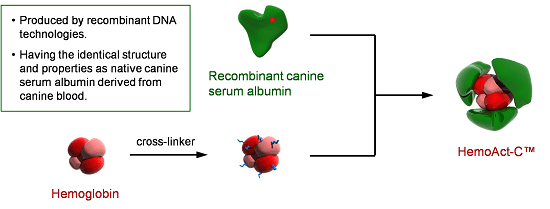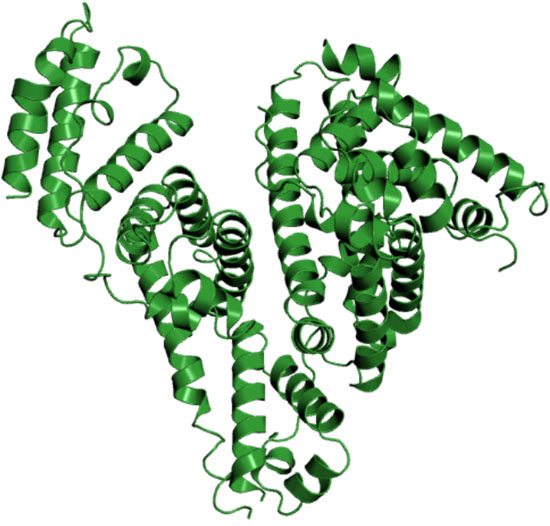Success of Synthesis and Structural Analysis of Artificial Blood for Dogs
— Encouraging solution for deficiency in transfusion blood and global demand —
Last Updated: November 11, 2016
Chuo University
Japan Aerospace Exploration Agency
Brief overview
A research group of Prof. Teruyuki Komatsu of Department of Applied Chemistry, Faculty of Science and Engineering, Chuo University and Dr. Kiyohito Kihira, a research and development staff of Japan Aerospace Exploration Agency (JAXA), succeeded at synthesis and structural analysis of artificial blood for dogs. First, Prof. Komatsu et al. produced recombinant canine serum albumin” (hereinafter called “rCSA”) and clarified its three-dimensional structure through X-ray crystal structure analysis. Furthermore, they synthesized a (hemoglobin-rCSA) cluster, in which the rCSA encloses hemoglobin, oxygen-carrying protein (product name: HemoAct-C™), and demonstrated that HemoAct-C™ functions as an artificial oxygen-carrier (alternative for red blood cells) for dogs. A high quality protein crystallization technology (Hyper-Qpro) developed by JAXA was applied to the X-ray crystal structure analysis. This is a breakthrough invention to resolve a serious problem of securing transfusion blood for animal medical practice, and it is expected that it would greatly contribute to transfusion treatment in animals. These research results were published in an online journal, Scientific Reports (Nature Publishing Group), a British science journal, on November 10, 2016.
| [Researcher] | Teruyuki Komatsu (Professor, Department of Applied Chemistry, Faculty of Science and Engineering, Chuo University) Kiyohito Kihira (Research and development staff, Japan Aerospace Exploration Agency (JAXA)) |
| [Journal] | Nature Publishing Group, Scientific Reports 2016, 6, in press Article Tittle: “Artificial Blood for Dogs” DOI: 10.1038/srep36782 |
[Research content]
1. Background
Japan is a major pet-loving country, in which more than 19.79 million cats and dogs are reared. The number of these pets is far greater than the number of young people (under 15-years old), 16.04 million children (data from the Bureau of Statistics, Ministry of Internal Affairs and Communications). Recently aging and obesity pets are advancing, and the demand for animal medical care is increasing year by year. However, the environment of such animal medical care has not been in place because there is no blood stock system for pet animals regarding “blood transfusion”. For severely affected animals (cats and dogs) requiring a blood transfusion therapy, blood donors are prepared by veterinarian himself/herself to endure transfusion blood as it now stands. In other words, the greatest challenge in blood transfusion therapy for pets is securement of donors providing blood.
If a system that always stores artificial blood for pet animals in animal hospitals to provide it for pet animals with heavy bleeding or anemia is established, not only securement of donors but also blood compatibility test are not needed any more; and, as the results, blood transfusion procedure becomes greatly simplified. Products with excellent preservation stability also enable thoroughgoing emergency measures. In other words, there are high demands for artificial blood, especially “artificial oxygen-carrier, which is an alternative for red blood cells” in animal medical practice having a serious problem, and development and realization of them are strongly desired.
For artificial oxygen-carrier for dogs, Bovine hemoglobin*1 polymer has been previously manufactured and marketed as a therapeutic agent for dogs with anemia in the United States and United Kingdom [product name: Oxyglobin® (former Biopure, US)]; however, a number of side effects including discoloration of the skin, mucosa and urine, black stools, decreased appetite and fever have been reported.
2. Study results
Komatsu et al. synthesized safe artificial oxygen-carrier for dogs that can be stored for long periods and used no matter when or where regardless of blood type, and clarified that the artificial oxygen-carrier can be used as a clinically applicable alternative for red blood cells in this study. More specifically, a (hemoglobin-rCSA) cluster, in which three molecules of the rCSA*2 are covalently bonded on the molecular surface of bovine hemoglobin, (product name: HemoAct-C™, Fig. 1) was developed, and its structure, physical properties and oxygen-binding ability were clarified.
In case of products for animals, hemoglobin, which is a core of the cluster, must be covered with serum albumin derived from the animal. However, securing sufficient amount of canine serum albumin required for the manufacturing is impossible. Therefore, Komatsu et al. took advantage of gene recombination techniques to artificially produce canine serum albumin. Furthermore, they succeeded X-ray crystal structure analysis*3 of the artificial canine serum albumin for the first time to clarify its three-dimensional structure (Fig. 2).
Because the production of rCSA became possible, an artificial oxygen-carrier for dogs, “HemoAct-C™” completed. In, Hyper-Qpro,*4 which is high quality protein crystallization technology developed through experiments implemented by JAXA in the International Space Station, was applied to the X-ray crystal structure analysis of rCSA.
The precise molecular structure clarified in this study is used as the fundamental information to explain various data obtained from studies implemented aiming at commercialization of “HemoAct-C™”, and as information ensuring the safety of a formulation.
It is expected that these results of the study not only greatly contribute to promotion of good health in pets but also would provide significant spillover effects on the entire animal medical treatment as well as our human life.
The followings are a brief summary of the key accomplishments of this study:
- A rCSA was produced through genetic engineering techniques. The physical properties of the rCSA were identical to those of canine serum albumin derived from the blood. Furthermore, the three-dimensional structure of the rCSA was clarified based on X-ray crystal structure analysis for the first time (collaboration between Chuo University and JAXA).
- A (hemoglobin-rCSA) cluster, in which the rCSA encloses bovine hemoglobin, (product name: HemoAct-C™) was synthesized, and its structure and oxygen-binding ability were demonstrated.
- HemoAct-C™ does not leak out from the vascular endothelial cell because the surface of HemoAct-C™ is negatively charged, and there are no side effects such as increased blood pressure. It is considered that the half-life in blood is longer than that of albumin.
- Raw materials are only hemoglobin, rCSA and cross-linker (a marketed product). The manufacturing process consists of only 2 steps. HemoAct-C™ is easy to synthesize. No special devices are required.
- The rCSA alone can be used as an artificial plasma expander; therefore, a number of applications are expected.
3. Purposes and application areas
Establishment of a system that can provide artificial oxygen-carrier for dogs that can be stored for long periods for routine or emergency medical cares by storing it in animal hospitals as solution or powder at all times is a long-held dream in animal medical care. The market of artificial blood, which can immediately deal with a large quantity of demand during an emergency, can be stored for long periods, has no blood types, has no concern of virus infection, and can be used no matter when or where, ranges spans the the entire world including developed and developing countries.
HemoAct-C™ has various purposes and application areas. For example, in addition to uses as an alternative for red blood cells (resuscitation fluid for hemorrhage shock, replenisher solution during intraoperative hemorrhage, oxygen-supply solution used during transportation to hospital, oxygen-supply solution for dogs with anemia), applications as oxygen-supply solution for ischemia regions caused by heart failure, cerebral infarction and respiratory failure; replenisher solution for an extracorporeal circulation circuit, sensitizer for cancer treatment and others may be possible.
HemoAct-C™ is a breakthrough invention to resolve a serious problem of securing blood donors for animal medical practice at once, and it is expected that it would greatly contribute to transfusion therapy in animals.
Currently, a cooperative development with Kyoritsu Seiyaku Corporation aiming at commercialization of this formulation is proceeded.
4. Outlook for the future (Application to human)
Development of artificial oxygen-carrier for human aiming at clinical application has started in Europe, the United States and Japan since the 1990s, and intramolecularly cross-linked hemoglobin, hemoglobin polymer, polymer‐bound hemoglobin and others, which are produced by processing of hemoglobin, have been manufactured. However, it has not been put to practical use because of side effects (increased blood pressure due to vasoconstriction) and others.
The above research results were about artificial blood for dogs, but research for human application is also in process. Currently, the research team is proceeding with crystallization and analysis of the three-dimensional structure of HemoAct™ using protein crystallization technology of JAXA in the Japanese Experiment Module (JEM) “Kibo” of the International Space Station, and design artificial oxygen-carriers with higher advantageous effect.
[Contacts]
- Information about research
- Teruyuki Komatsu
Professor of Department of Applied Chemistry, Faculty of Science and Engineering, Chuo University
TEL: 03-3817-1910 (direct line), or 03-3817-1894 (office of Department of Applied Chemistry)
E-mail: komatsu@kc.chuo-u.ac.jp - Information about public relations
- Yuuki Kato
Research Support Office, Chuo University
TEL: 03-3817-1603、FAX:03-3817-1677
E-mail: k-shien@tamajs.chuo-u.ac.jp - Information about protein crystallization experiments using the International Space Station
- Public Affairs Department, Japan Aerospace Exploration Agency (JAXA)
TEL: 050-3362-4374, FAX: 03-3258-5051
[Glossary]
*1: Hemoglobin
Hemoglobin is a hemoprotein contained in red blood cell in blood of all animals including human. Molecular weight of hemoglobin is 64,500. Hemoglobin has ability to bind with oxygen molecules in a reversible manner and assumes a role to transfer oxygen from the lung to the periphery in the body.
*2: Serum albumin
Serum albumin is simple protein that most abundantly exists in animal serum. Molecular weight of canine serum albumin is 65,700. Serum albumin accounts for about 60% of total protein in the serum, and play the role in maintenance of colloid osmotic pressure and storage and transportation of a variety of endogenous and exogenous substances (metabolic products and drug etc.).
*3: X-ray crystal structure analysis
X-ray crystal structure analysis is a method to elucidate the three-dimensional structure of substances by irradiating a crystal with X-rays to obtain X-ray diffraction patterns, from which the electron density distribution of the crystal is calculated.
**4: Hyper-Qpro
Hyper-Qpro is a collective term of a suite of technologies applied to maximize the improvement effect on the quality of crystals produced in space in high quality protein crystallization experiments conducted in the Japanese Experiment Module (JEM), known as “Kibo”, of JAXA. In this process, physical properties (charge, dispersity etc.) of proteins in solution are comprehensively evaluated, if needed, samples are highly purified, and then crystallized. It is expected that high-quality crystals would become available not only in space but also on earth.

Figure 1. HemoAct-C™ has the structure that recombinant canine serum albumin encloses hemoglobin purified from bovine red blood cells. It is expected that HemoAct-C™ achieves a revolution in transfusion treatment in canine.

Figure 2. Three-dimensional structure of recombinant canine serum albumin clarified through X-ray crystal structure analysis (collaboration between Chuo University and JAXA).
*All times are Japan Standard Time (JST)
Comments are closed.